Imagine an inner monologue like this every time you step onto the court to play a new opponent.
“I don’t know who you are. I don’t know your level, playing style, or how fast your racket is. If you’re looking to outplay me, I can tell you that I’m still learning, but what I do have is a very particular selection of shots. Badminton shots I have acquired over long and repetitive training sessions. Shots that can be a nightmare for other players to deal with…”
While it would be quite intense to start your games as the badminton version of Liam Neeson, there is something to be said about learning the different badminton shot types as early in your badminton career as possible.
Pretty much every shot in badminton is developed for a specific purpose and used to handle specific scenarios.
As a beginner, you might be able to get along knowing only three or four different types of shots, but you quickly become outmatched when you play opponents who have even a basic grasp of all the standard variants.
To make sure other players don’t just run you over because your game is too one-dimensional, I’ll give you a breakdown of every standard badminton shot that you should adopt in your game (if you haven’t already.)
After this, you’ll know how to practice and develop the different shot types, and later, use them tactically in matches as a very particular set of skills to make yourself an overall better badminton player.
Badminton shot types: 8 shots that belong in your skillset
- Service

The first of the badminton shot names is also the first of every rally – service.
The most common style is to hold out the shuttlecock in your non-racket arm, let it drop, and then flick it with your racket to send it over the net.
I previously covered badminton service in a post about the best badminton racket for intermediate players, if you want to take a closer look at the different types of service you can play.
Serving can sometimes feel quite strict, and you’ll get fouled if you don’t adhere to the specific service rules.
According to the Badminton World Federation, here are some of the important ones:
- You can’t delay service once you move your racket backward (a.k.a. don’t take too long to serve)
- It has to be a fluid movement back to front (no stopping or tricking)
- Both server and receiver need to stand diagonally from each other and have their feet within the lines of the service court
- You have to strike at the cork, not the feathers
- Both feet should have contact with the floor when serving
- The shuttle has to be hit below 1.15 meters
Within these perimeters, serving comes intuitively (for the most part).
However, you should remember when you’re serving it’s all about setting your opponent up for a weak return.
You want to avoid serving to your opponent around shoulder height as it will be too easy for them to hit the shuttle downward and win a point fast.
Instead, you should serve low to the front so your opponent returns the shuttle under net height, or just at net height, which will result in a weaker return.
Another option is to hit the shuttle far to the back so your opponent has to skip backward and return it with an overhead stroke (a clear, smash or drop).
When you’re the one returning service, your stance should have your racket leg behind to push forward for a low and short serve under the net.
Your non-racket leg should be in front and ready to push off to skip backward if you need to return a long and high serve.
Once the rally starts, a clear shot is one of the most fundamental shots in your toolkit.
You hit a clear shot with a precise snap in your racket swing but spend much less energy and power than you would in a smash.
You can clear defensively by hitting the shuttle to the back of the court with a long and high shot to get more time to compose your position and stance.
It can also be used as an attacking shot when your opponent is on the front court to push them back and set up an attacking advantage.
Keep in mind that if you overexert power in your clear shots, you’ll risk striking out of the court too often.
As you improve your technique, you’ll clear with low-energy effort, using more of a snap motion rather than following through on the stroke.
Here’s an example where Tai Tzu-Ying hits a clear shot against Ratchanok Intanon. Her setup is similar to a smash making this a “disguised” clear shot that results in pushing her opponent to the rear court and getting a weaker return.
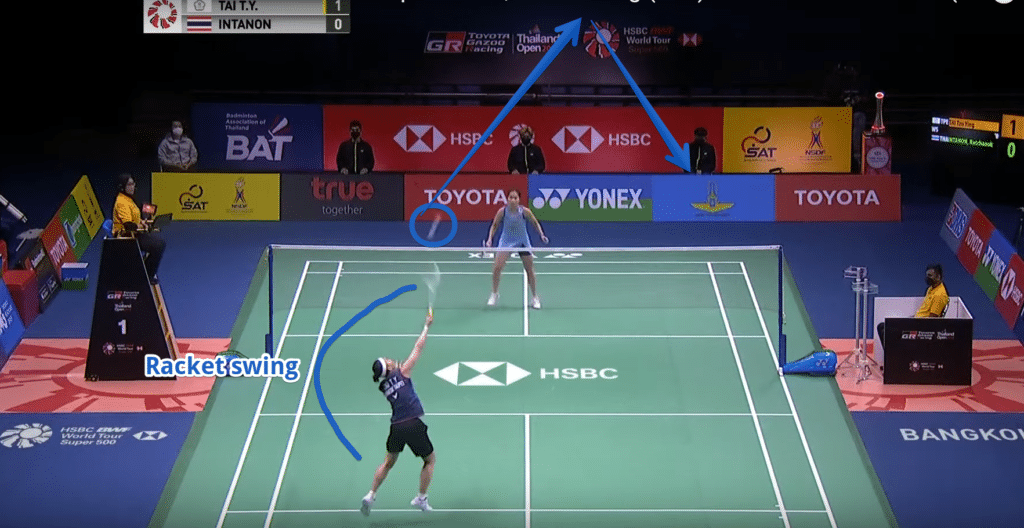
- The Drive shot
This type of shot typically has a lower striking power, getting most of its movement from your wrist and utilizing your footwork and stance by stepping forward and punching the shuttlecock.

Drive shots are all about timing.
If you hit the drive with too much power, the shuttle will fly too high to create any real problems for your opponent, who could instead return it with a smash.
You want to restrict your full power and lunge forward into the drive, tensing up your grip before impact to achieve the punch action in the shot.
It can be done as a forehand and backhand shot.
The forehand drive will come across holding the racket high (above your chest) and chopping forward in your swing to attack the shuttle.
The backhand drive will set up similarly, but your racket is lower (around or under your chest), snapping away from your body rather than a swinging shot.
Drive shots are often quick exchanges played directly at your opponent’s body. You tend to see more of these in double matches where they’ll drive each other to oblivion in shot exchanges that look and feel like a whirlwind of shots.
In single matches, it’s great for sending fast shuttles at open areas of your opponent’s court.
Here’s an attacking drive example from a legend.
Forehand drive shot – Lin Dan.

Backhand drive shot – Lin Dan. Notice how his racket is much lower in the backhand drive.
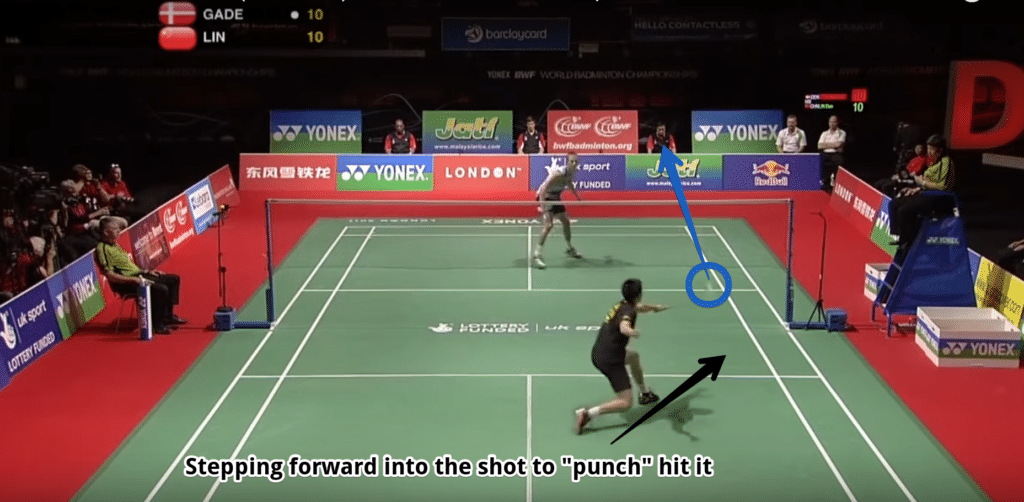
Watch him play both drive shots in the first ten seconds of this clip.
In the first ten seconds of this clip, there’s a series of drive shots from both players (notice the rapid exchange and how the drives have a direct trajectory).
- The Drop shot
The drop shot is a slightly tricky shot where you pretend to hit a clear (or smash) but instead, pull back on your racket power before contact with the shuttle so it drops to the front rather than flying to the rear court.
Drop shots can be played in a variety of ways, but basic successful drops dive right over the top of the net and are hard to return, especially if you’re expecting a clear.
Here’s an example from Tai Tzu-Ying.
The drop shot is “disguised” – it looks like she’s setting up to hit a clear or smash…

She then reduces the speed of the followthrough to create a drop shot instead, completely catching her opponent off guard. Notice the finishing angle of her racket that drives the shuttle just over the net.
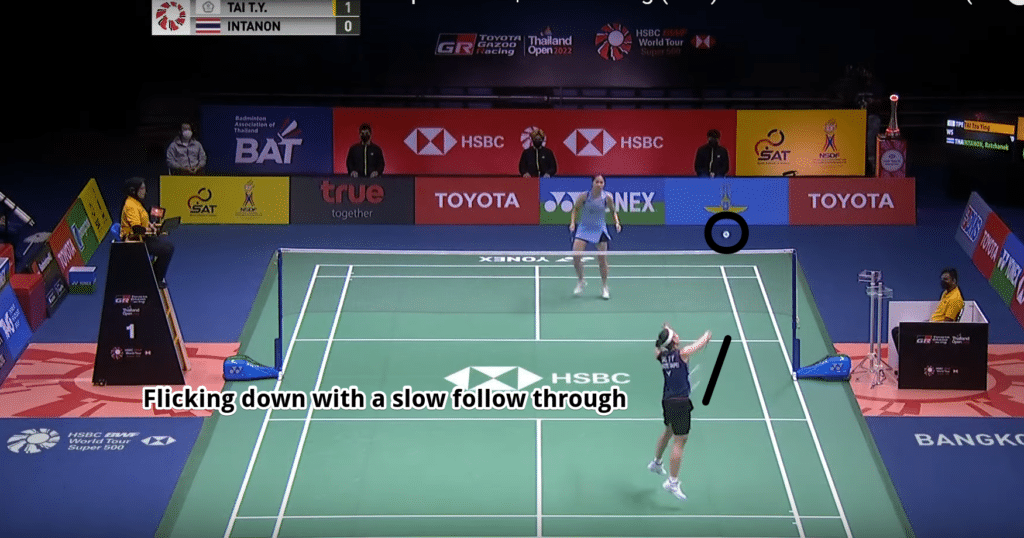
Watch her play it here to win a point (first five seconds.)
If you want to take a deeper plunge, I cover everything about the badminton drop shot here – from the basic version to the more advanced variations and how to defend against it.
- The Lift shot/Net lift
The lift is often considered a defensive shot to get yourself out of pressure and reset the rally (sometimes, it’s the only shot that can get you out).
After a few net exchanges, one player will often lift the shuttle with a snap swing below the hip to push the other player to the backcourt, effectively ending the net battle and giving you time to collect yourself.
At the same time, it opens an opportunity for the other player to attack the shuttle with a smash, drop, or clear because the shuttle will drop straight down from a high trajectory at a nearly 90-degree angle.
However, attacking a shuttle this way requires good technique and focus, and if your opponent doesn’t have good footwork to move back from the net, they can quickly end up in an awkward position to attack.
To minimize strong attacks, good lifts are always high and long and as accurate to the rear court as they can be without going out.
If you look at professional badminton players, they lift often and use it both as a defensive net move and also to move their opponent around.
For example, Viktor Axelsen uses lifts often – effectively pushing opponents to the rear court, second-guessing whether the shuttle is on or out (he sometimes wins points just because other players think the shuttle will go out).
He lifts together with short drops or net shots to constantly keep his opponent moving from the net to the back. In long rallies, this can be tiring because they need effective and fluid footwork and often travel further on the court, which depletes energy throughout a match.
Here’s a clip where Viktor Axelsen moves Lee Zii Jia back and forth with a combination of “lift/net shot/lift/net shot” – while he barely moves on his side of the court.
- The Smash shot
The most powerful, the fastest, and for most players, the most exciting shot in badminton to hit (and watch), filling you with a feeling of joy that’s hard to describe.
It’s the one shot that makes most players fall in love with the game.
Smashes are exclusively attacking shots and typically come in two versions.
The first version is a standing smash.
A standing smash is for smaller attack opportunities that don’t present themselves as ideal high and slow-flying birdies. Typically, you hit this shot when someone returns a weak defensive shot or makes a mistake that results in a less accurate and powerful stroke, like lower lifts or unsuccessful drives.
The second version is the jump smash.
Typically the shuttle is sailing high through the air, and you anticipate an opportunity to jump up, swing your racket from the back, and follow through while extending your body down through your toes to generate maximum power.
It can be used as a powerful attack everywhere on the court but typically from the rear court and to attack clears and lifts.
Most players learn how to smash reasonably well in terms of power but less so for controlling where the shuttle goes. But if you can smash down the line and to the front court with enough precision, it’s even deadlier.
Here’s an example where Viktor Axelsen hits a standing smash. He extends his front leg while pushing against his back leg, swinging the racket from a downward angle to generate maximum power.

Here’s the jump smash. Notice the full extension of the body and racket at the perfect time to hit an accurate and fast shuttle along the side of the court.
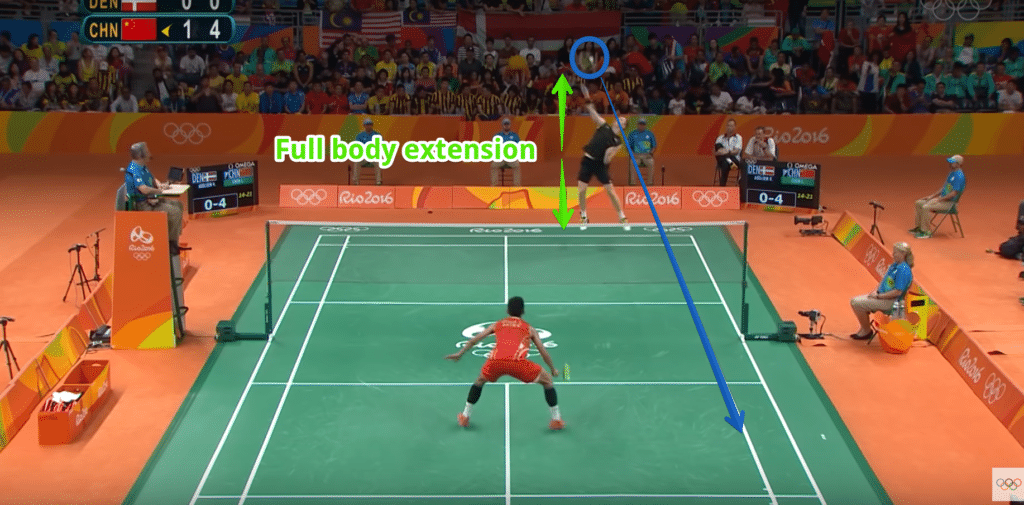
Watch the first ten seconds of this clip. The standing smash is first, then the jump smash.
- The Net shot/Net drop
During a badminton match, you’ll inevitably end up by the net and fight out who has the better finesse and net control until someone lifts or the shuttle gets too difficult to return.
Net battles are intense in pressure, and a few exchanges back and forth can quickly lead to an impossible shuttlecock that rolls over the net and drops like a sack of potatoes, or equally possible, an error where you hit the shuttle into the net because you were too close.
Net battles are about small margins, and the difference between fault and expert control is a delicate balance.
You play this shot by tapping the shuttle gently while lunging at it. There’s no racket swing involved, but sometimes you might flick your wrist to add extra power if needed.
You’ll typically play this as an attacking shot to return a drop shot. Most drop shots come from the rear court, which forces your opponent to run up to the net to defend it.
A lot of the time, net shots get returned with another net shot, and players with great technique will make the shuttle sail inches over the net, often touching the net cord as it rolls over.
Here’s an example of a tense net battle with several exchanges of net shots. Notice how each player lunges at the shuttle with their racket arm to “tap the shuttle” each time they play this shot.
- The Net kill/Kill shot
A net kill is a shot you hit right on the net at a steep downward angle to win a point by “killing” the shuttle.
To hit a net kill you have to react quickly, and most of the time this shot presents itself after a weak reaction or defensive shot from your opponent where the shuttle travels mid-air and short.
It’s a shot that often wins you a point in net battles if you’re ready to pick out a shuttle that’s returned too high.
Here’s another example where Kevin Sanjaya finishes the point with a net kill.
Before I move on to the next chapter: if you’re looking for a racket that can help perform all of these shots well and generally be good all-around, consider looking at the Yonex Arcsaber 11 Play.
Avoid becoming a one-trick pony
When practicing the different shots in badminton it’s a good idea to go through the following three phases to fully incorporate each shot into your game.
- Start by focusing on each shot individually until you can hit it “good enough”
- Next, practice different types of shots in combinations to assimilate a more realistic match situation
- Finally, you’ll hit these shots in competition and training matches to the best of your ability, and discover where your strengths and weaknesses lie
All the shots above are considered standard shots, and you’ll have great use for all of them throughout a match. It’s a good idea to start by approaching these shots as a broad palette of options in your game rather than getting overly obsessed with perfecting one specific shot.
You want these shots to be “good enough” first, and later you can obsess over a precise net shot, a deceptive drop shot, a rally-ending smash, etc.
Of course, there are more advanced variations for each of these badminton strikes, but if you get too focused on developing several variations of one specific shot before you know how to strike all the “standard” shots, you might end up with big holes in your game.
Finally, you can incorporate your practice into drop-in sessions, training matches, and real matches and use your shot knowledge to outplay your opponent.
Diversify each of the badminton shot types tactically and make your game impossible to read
Badminton is a game where anticipating your opponent’s next move makes it incredibly easy to take another player’s game apart and demolish it completely.
So you want to avoid being predictable at any cost.
It’s not unusual for most players to have a preferred playing style and to be a lot stronger in certain aspects of the game, but if you pursue this with obvious intention, your opponent will quickly discover your game plan and pull every rally in the opposite direction to exploit your weaknesses.
For example, if I play against someone who keeps winning points with net shots, I know they’ll want to push the game to the net by striking drop shots to trigger a short and weaker return so they can get into a net exchange.
They might win a lot of points in the first rallies, but once I discover this trend (which even beginners pick up on relatively fast), it gets predictable where they want each rally to go, and I can easily defend and counter because I’ll know what kind of shots to expect.
However, if that same player also loves to attack with smashes, it becomes a lot harder to defend since I now have two very different types of shots to take into account, which means I can’t just lurk up and position myself ready to move on the front court.
You can see how learning the different types of shots to the point where they’re “good enough” becomes vital here because you can add variation to your rallies and avoid being predictable.
An easy way to add variation with different badminton shot types
The trick is to have enough variation so that you can still play the style you prefer without becoming too obvious.
One of the easiest ways to practice shot variation so it becomes second nature rather than something you have to constantly think about is to set up your attacking game in shot combos.
Shot combos are great because of three things:
- They allow you the mental focus to prepare a specific strike
- They automatically bring in different types of shots
- They teach you how to fluidly adapt to different rally scenarios
They work because many shot types often warrant a certain returning strike. For example, a drop shot often results in a net shot return, and a lift often results in a mid-court attack.
Because attacks can provoke a certain defensive response, you can apply pressure on your opponent to play a shuttle that you’ll be expecting before they know it – an active way to gain control in a rally.
Of course, you can’t always expect shots to play out the way you want, and sometimes you’ll have to react to your opponent.
To use combos effectively, there are a few “rules” I’d recommend following.
- Combos are a tactical tool. They’re a means to an end, not your overall strategic game plan
- A combo should be simple enough that you easily remember what shots to play
- It should be short enough that there’s a realistic chance to play the full combo
- It should be easy to abort and start over multiple times in every rally
To stay within these “rules” I tend to keep combos no larger than three shots.
Three badminton shot combos to get you started
Combo 1
- Shot 1 – Clear to opponent’s backhand (non-racket arm)
Expecting a clear or drop in return
- Shot 2 – Net drop as close to the net cord as possible
Expecting a lift or high net shot
- Shot 3 – Smash or kill shot (smash on the lift, net kill on a weaker and higher net return)

Combo 2
- Shot 1 – Drop to the front court
Expecting a net shot in return
- Shot 2 – Net shot
Expecting another net shot return
- Shot 3 – Lift high to the rear court
Combo 3
- Shot 1 – Smash to opponents mid-court
Expecting a defensive reaction shot in return
- Shot 2 – Drive shot at the opponent
Expecting a weak reaction shot in return
- Shot 3 – Kill shot
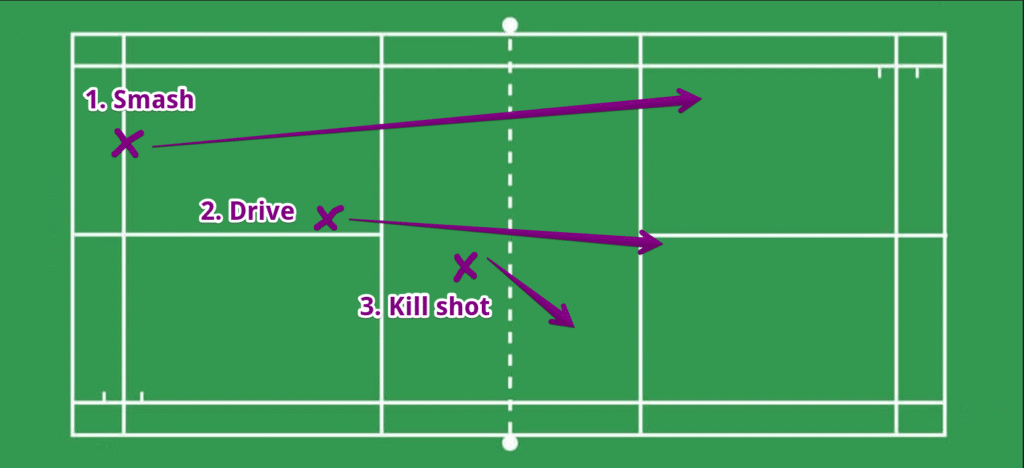
Remember, these are just examples to get you started, and you can create combos any way you want.
Variating your shots will automatically put pressure on your opponent to “figure you out”, and it will help make your stronger shots more effective because your opponent won’t expect to defend against them constantly.
So variation actually improves the stronger aspects of your game by making it less predictable.
Have you ever played someone where you kept shaking your head in frustration, thinking – “Ugh, this jacka** has been playing an attacking smash game for the first eight rallies, and now they suddenly keep clearing and dropping with barely any smashes at all? Can they just play every style in the game, or what’s their deal?”
That’s how you want your opponent to feel.
If you want to explore tactical aspects further and learn how to abuse your opponent’s stamina and tire them out or handle mental pressure, you can learn more about it in this post on tactics for badminton.
Takeaways
- There are eight standard shots that all badminton players should have in their skillset – service, clear, drive, drop, lift, smash, net shot, and net kill
- It’s better to learn all the different shot types to a point where they are “good enough” before perfecting either of them
- Start by practicing each shot individually, then learn how to switch between different types of shots, fluidly
- Use shot combos as a tactical advantage in training game matches to variate your shots on autopilot and make it harder for opponents to read your game








